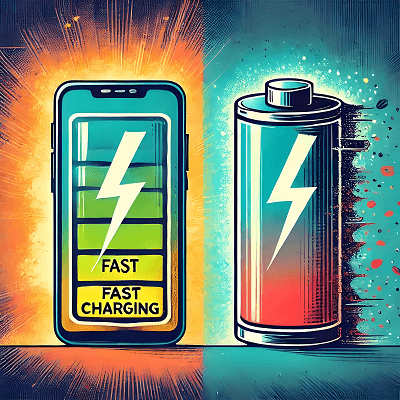Lithium polymer batteries (LiPo) are widely used in smart phones, drones, wearable devices and other fields due to their high energy density battery, thinness and flexibility. However, many users have doubts about the difference between "fast charging" and "standard charging": Is fast charging safe? Why do you sometimes need to choose slow charging? This article will reveal the core difference between the two from the perspective of technical principles, performance impact and practical application.

I. Charging speed: the game between current and time
1. Standard charging (slow charging)
- Current intensity: usually charged with a small current of 0.2C~0.5C (C is the battery capacity). For example, 0.5C of a 1000mAh battery is 500mA.
- Charging time: about 2~4 hours to fully charge, the current is gentle, reducing the internal pressure of the battery.
2. Fast charging (fast charging)
- Current intensity: can reach 1C~5C (such as a 1000mAh battery charged at 3A current), and the current intensity is significantly improved.
- Charging time: Some fast charging technologies (such as the "50% charge in 30 minutes" of mobile phone manufacturers) are shortened to less than 1 hour through optimization algorithms.
Core difference: Fast charging shortens the charging time by increasing the current or voltage, but it places higher requirements on battery materials and circuit design.
II. Differences in refined management of charging stages
Whether it is fast charging or standard charging, it needs to go through two stages: **constant current (CC) and constant voltage (CV),** but the management strategies are completely different:
- Standard charging:
a. Constant current stage: charge with a stable current until the battery voltage is close to the upper limit (such as 4.2V).
b. Constant voltage stage: keep the voltage constant and gradually reduce the current until it is full. Gentle throughout the process to avoid polarization effects.
- Fast charging:
a. Multi-stage regulation: by dynamically adjusting the current/voltage, such as "first large current fast charging, then step-by-step reduction of current".
b. Intelligent algorithm support: rely on BMS (battery management system) to monitor temperature and voltage in real time to prevent overcharging or overheating.
III. Temperature control: the "double-edged sword" of fast charging
- The heating challenge of fast charging:
High current will cause the internal resistance of the battery to heat up (Joule heat Q=I²R). If the heat dissipation is insufficient, it may cause the following problems:
a. The electrolyte decomposes and produces gas, causing bulging;
b. The SEI film (solid electrolyte interface) grows excessively, accelerating capacity decay.
- Solution:
a. Hardware design: Use a multi-layer heat dissipation structure or liquid cooling technology (such as electric vehicle fast charging).
b. Software current limiting: When the temperature exceeds the threshold (such as 45°C), the BMS automatically reduces the charging current.
IV. Battery life: The invisible cost of fast charging
- Standard charging:
Low current charging can reduce the electrode stress during lithium ion battery insertion/extraction and extend the cycle life (usually up to 500~800 times).
- Impact of fast charging:
a. High current accelerates the destruction of the electrode material lattice structure, and the cycle life may be reduced to 300~500 times;
b. Long-term fast charging may cause premature capacity decay (such as 80% remaining capacity after 1 year vs 85%~90% of standard charging).
V. Core requirements for safety design
- Additional protection for fast charging:
a. Voltage/current accuracy: The charger and BMS are required to work together, and the error must be controlled within ±1%;
b. Multiple protection mechanisms: including overvoltage protection (OVP), overtemperature protection (OTP) and short circuit protection.
- Advantages of standard charging:
Lower risk, suitable for scenarios with extremely high safety requirements (such as medical equipment, long-term plug-in equipment).
VI. How to choose a charging method?
1. Recommended fast charging scenarios:
- Emergency charging (such as fast charging of mobile phones before going out).
- Devices that support active heat dissipation (such as electric vehicles, high-end drones).
2. Recommended standard charging scenarios:
- Charging at night or charging before long-term storage.
- Old batteries (capacity decay has occurred).
Conclusion: Balancing efficiency and lifespan
Fast charging technology has greatly improved the user experience, but behind it are joint breakthroughs in material science, thermal management, and intelligent algorithms. As a user, choosing a reasonable charging strategy (such as "standard charging when not urgently needed") can not only enjoy convenience but also extend battery life. In the future, with the popularization of new technologies such as solid-state batteries, the "fast and safe" charging experience may no longer be contradictory.


